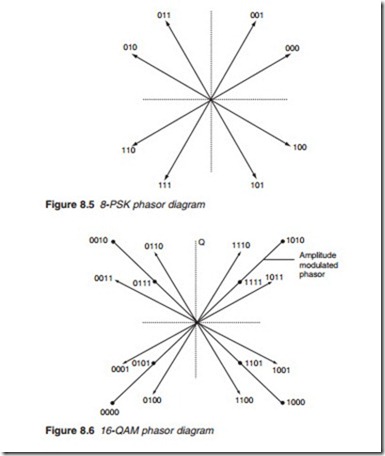Phase shift keying
A digital signal has only two states, 1 and 0, and when it is used to mod- ulate a carrier, only two states of the carrier amplitude, frequency or phase are necessary to convey the digital information. In terms of bandwidth, the most economical form of modulation is phase modulation, known as phase shift keying (PSK). Here, the carrier frequency remains constant while its phase changes in discrete quantities in accordance with the logic state of the data bit. Binary PSK (BPSK) is a two-phase modulation tech- nique in which the carrier is transmitted with a reference phase to indicate logic 1 and a phase change of 180º to indicate logic 0.
In quadrature phase shift keying (QPSK), also known as 4-phase PSK, the serial bitstream is first converted into a 2-bit parallel format using a
serial-to-parallel converter. The instantaneous states of each pair of bits, known as dibits, can take one of four combinations, namely 00, 01, 10 and
11. For each of these combinations, the carrier is set to a particular phase angle (Table 8.1). The carrier has four phases: 45º, 135º, 225º and 315º. For example, data 00 and 10 are represented by 45º and 225º, respectively. The four phases are obtained from two quadrature (at right angles) carriers having the same frequency (Figure 8.4) I (in-phase) and Q (quadrature). Each phase is used to represent a 2-bit combination known as a symbol (Table 8.1). As can be seen, the bit rate is twice the symbol rate (also known as the baud rate). It is the symbol rate, i.e. the rate of phase change that determines the bandwidth. For the same bandwidth, twice as much infor- mation can thus be sent using QPSK compared with BPSK.
Differential phase shift keying (DPSK) has no specific reference phase. A phase shift occurs only if the current bit is different from the previous bit. The phase reference is therefore the previously transmitted signal phase. The advantage of this technique is that the receiver and the trans- mitter do not have to maintain an absolute phase reference with which the phase of the received signal is compared. DQPSK combines the advan- tages of QPSK and DPSK.
Phase shift keying may be improved by increasing the number of carrier phase angles from 4 in the case of QPSK to 8 or 16 in the case of 8-PSK and 16-PSK, respectively. In 8-PSK, the carrier may have one of eight different phase angles (Figure 8.5) with each phasor representing one of eight 3-bit combinations.

